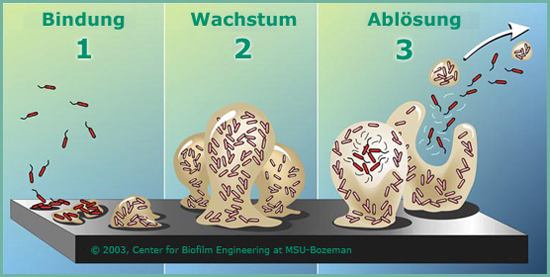Characterization of biofilm EPS
To date, it is recognised that microorganisms such as bacteria, algae or fungi can form highly organised communities embedded in a self-made extracellular matrix, known as “biofilms”. The self-made extracellular matrix of biofilms is mainly consisting of water that contains polysaccharides, proteins, nucleic acids or huminic acids and is called extracellular polymeric substances (EPS) matrix.
Composition and structure of the EPS is still under intense investigation since it was realised that the EPS greatly influence functional properties and development of the biofilm. Thus, the role of EPS is more than just a protective barrier. Moreover, there is the possibility that immune cells interact directly with components of the EPS.

Stadien der Biofilmentwicklung nach P.Dirkx, Center of Biofilm Engineering, Montana State University 2003
In this task we are focussed on the following questions:
- What is the role of EPS during biofilm development?
- How does the EPS composition change during biofilm formation and development?
- Are EPS components involved in biofilm immune cell interactions (Inter-kingdom Signalling)?
References
Meyle, E. / Brenner-Weiss, G. / Obst, U. / Prior, B. / Hänsch, G. (2012): „Immune defense against S. epidermidis biofilms: components of the extracellular polymeric substance activate distinct bactericidal mechanisms of phagocytic cells“. In: Int J Artif Organs (2012)
Hänsch, G.M. / Brenner-Weiss, G. / Prior, B. / Wagner, C. / Obst, U. (2008): „The extracellular substance of Pseudomonas aeruginosa: too slippery for neutrophils to migrate on?“. In: Int. J. Artif. Organs. 31 (2008), 9, 796-803
